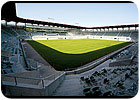
A state-of-the art hydronic earth-warming system was built beneath the surface of the lawn to keep the field at AFG Arena in St. Gallen, Switzerland play-ready. (Photo courtesy of AFG Arena.)
The 2008 European Cup started a week early for 18,000 football fans in St. Gallen, as the Swiss National Team christened the new AFG Arena in an exhibition match against Liechtenstein on May 30, 2008. The natural turf of the pitch was in top condition for the cup co-host’s final match before the opening ceremony of the pan-European UEFA EURO 2008™ tournament in Basel.
The playing surface was still pristine a month later for home club FC St. Gallen’s first match in the new arena. Stadium operators say they expect the pitch to remain in excellent shape throughout the club’s upcoming season, thanks in part to an under-the-turf heat transfer system.
SOCCER PITCH HEATED FROM BELOW
Located at the foot of the Appenzell Alps 675 meters above sea level, St. Gallen boasts one of the highest elevations in Swiss soccer, second only to FC La-Chaux-de-Fonds in the Swiss Challenge League. Temperatures routinely dip to –12° C in the winter months, and snowfall of up to a half-meter is not uncom-mon.To keep the pitch playable in harsh winter conditions, a state-of-the art hydronic earth-warming system was built beneath the surface of the lawn. The system includes 27.7 kilometers of tubing containing nearly 17,000 liters of heat transfer fluid. The fluid is a 30% solution of DOWCAL™ 10 Inhibited Ethylene glycol-based fluid and deionized water.
During freezing conditions, the system - made up of four 2,500-liter boilers, nine 1,200 kW heat transfer exchangers, 71 pumps, and 27.7 kilometers of tub-ing - is used to thaw the turf before each match and keep it from freezing during play. Heat from the boilers is used to raise the temperature of the fluid to 35°C as it passes through the heat exchangers. The temperature falls below 20°C before it reaches the roots of the grass, a temperature that will produce re-sponsive turf while not causing heat damage to the grass.
By employing multiple smaller zones to heat portions of the playing surface instead of a single large loop, engineers ensured that the heat transfer fluid remains within an acceptable temperature range from the time it leaves the heat exchanger until it returns for reheating. Pumps circulate the fluid through 123 continuous loops to deliver heat across the pitch from sideline to sideline and from goal to goal. Each loop is an average 225 meters in length and made of crosslink polyethylene tubing with a 25-mm diameter. The tubing is installed 30 cm underground and 25 cm apart to deliver heat evenly to the entire playing surface and keep the ground thawed in al-most any weather condition.
HEAT DELIVERED TO THE PITCH
DOWCAL™ 10 Fluid is well-suited to provide necessary heating in harsh winter conditions. The fluid can operate at temperatures as high as 175°C, much higher than the fluid temperatures called for in the system design.The system is only used before and during football matches, standing idle and unheated between those events. The heat transfer fluid must protect the system from damage due to freeze-up when it is not in operation. While plain water could freeze solid and expand, causing piping to burst, the 30% concentration of DOWCAL™10 Fluid will not freeze solid under the temperature extremes typical to St. Gallen.
In addition, the 30% concentration DOWCAL™10 enables the water-based solution to remain pumpable at temperatures as low as –18° C, far lower than the freezing point of plain water, which is important for cold weather start-up and in the event of a temporary loss of heating to the system.
The low temperature performance of DOWCAL™10 Fluid results from the fluid’s relatively low viscosity when conditions are very cold. The low viscosity and resulting pumpability of the fluid can also reduce the pumping effort required to circulate the heat transfer fluid, which is expected to contribute to the energy efficiency of the heat transfer system.
A PROVEN RECORD
A PROVEN RECORDThe AFG Arena is the centerpiece of a 50,000-sq-meter, 340-million-franc, mixed-use project that replaces St. Gallen’s historic Espenmoos Stadion with the largest sports, shopping and recreational facility in Eastern Switzerland. Planning for the project began during FC St. Gallen’s Axpo Super League champi-onship season in 1999, but it was not until late 2007 and early 2008 that the multiphase project reached completion, the club’s last season in the league before its move to the Swiss Challenge League.
Those involved with the arena project say there was never a doubt that they would use DOWCAL™ Fluid to provide heat to the playing surface. They point to the Stade de Genève in Geneva, home of Swiss Challenge League foe Servette FC, as just one example of the successful use of DOWCAL™ in a stadium project.
“We’ve known from the beginning of this project that the stadium would be using DOWCAL™ 10,” said Andreas Bosshardt, president of BOSS Chemie AG in St. Gallen, the chemical supplier that recommended and delivered the heat transfer fluid. “This stadium is going to see some very cold winters and a lot of snow. The planners knew the turf needed to withstand the coldest of temperatures and would need the most efficient heat transfer fluid available.” ES
